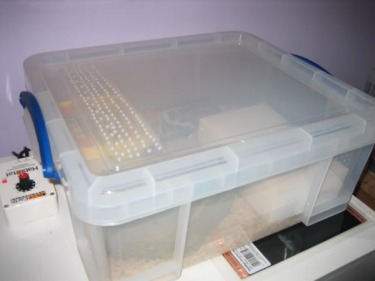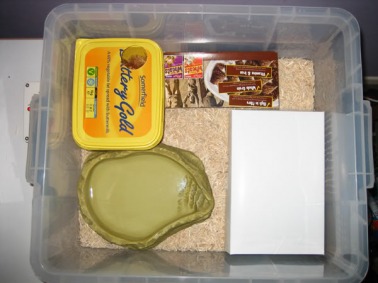PLEASE NOTE
The information on the BambooZoo site is as much as 10 years old and in the hobby much has been learned. Though, I believe there is merit in keeping the site open. There are many controversial issues presented in these pages. Please view BambooZoo as a starting point in your research.
These beings are as complicated as we are and deserve more than a basic 5 paragraph care sheet to maintain their health and well being.
My passion has changed. This is where I am today. Change the World.
HOUSING YOUR FIRST SNAKE
There's often a lot of questions about how to setup a home ready for your first snake. I thought I'd put some pictures together and explain a bit about the setups I used to have when my current snakes were 'iccle.
Below are my 'vivs':
This is my cornsnake Cecilia's home. The tub is a 20l Really Useful Box from Staples. One very useful feature of these boxes is that the handles clip onto the lid, securing the enclosure and hopefully preventing snake escape! You can see that I've drilled ventilation holes along the top on the cool side of the viv, and further down towards the bottom on the warm side. As hot air rises, this hopefully creates a flow of fresh air through the viv, whilst still retaining the heat.
Along the bottom towards the right of the viv, you can see the heatmat just poking out. The mat should cover one-third to one-half of the viv, to ensure that a temperature gradient is created. This means that your snake can move around to cool down or warm up until they are comfortable. Outside the viv to the rear you should just be able to make out the white box-shape that is the thermostat of the mat. A thermostat is essential as without one, the temperature of the heat mat goes unchecked and can rise to levels which may burn the snake - there are even stories of the substrate catching fire in extreme cases. I choose to put the probe for the thermostat in the viv itself - there is a hole drilled into the bottom right side, and the probe is fed through and sits on top of the substrate under the right-hand hide. Other people simply tape the probe to the heatmat outside the viv.. it's personal preference which method you choose to use.
Talking of substrate, I choose to use Aspen bedding for my snakes. A word of caution about this choice - I take my snakes out of the viv at feeding time and transfer them to another tub with kitchen roll on the bottom. There is a small risk of a snake ingesting bits of Aspen when they are eating, so I would not recommend feeding snakes in their vivs, although many people do and have no problems.
Along the bottom towards the right of the viv, you can see the heatmat just poking out. The mat should cover one-third to one-half of the viv, to ensure that a temperature gradient is created. This means that your snake can move around to cool down or warm up until they are comfortable. Outside the viv to the rear you should just be able to make out the white box-shape that is the thermostat of the mat. A thermostat is essential as without one, the temperature of the heat mat goes unchecked and can rise to levels which may burn the snake - there are even stories of the substrate catching fire in extreme cases. I choose to put the probe for the thermostat in the viv itself - there is a hole drilled into the bottom right side, and the probe is fed through and sits on top of the substrate under the right-hand hide. Other people simply tape the probe to the heatmat outside the viv.. it's personal preference which method you choose to use.
Talking of substrate, I choose to use Aspen bedding for my snakes. A word of caution about this choice - I take my snakes out of the viv at feeding time and transfer them to another tub with kitchen roll on the bottom. There is a small risk of a snake ingesting bits of Aspen when they are eating, so I would not recommend feeding snakes in their vivs, although many people do and have no problems.
This is a view inside the same box. On the far left of the box is a black thing on the floor. This is the display of my digital thermometer. You will also see a black wire coming down the right hand side of the viv, which is a secondary probe attached to the thermometer and sits under the warm-side hide. These 'in/out' thermometers are inexpensive, and allow temp readings to be taken at both ends of the viv, which allows you to adjust the temperature gradient until it is spot-on for the species of snake you are keeping. At the bottom left of the pic is a humid hide. This is a hide with a sealed bottom containing damp sphagnum moss, which gives the snake somewhere to go with increased humidity. This is especially useful around the time when your snake is shedding, as being too dry can cause incomplete sheds. This tub also has a branch in it for my corn to climb on - don't know why I bother really as it gets ignored most of the time, but at least she has the option! Another advantage of branches is that they provide a rough surface for the snake to rub their old skin on during shedding.
In the centre you can see my water bowl. In this setup, this is placed partially over the heat source to keep the background humidity in the viv at acceptible levels. The waterbowl should be big enough to allow the snake to curl up in it if they choose. If you do place your water dish over the heatsource as I have, ensure that it is cleaned and disinfected regularly as heat+water = bacteria growth.
On the right of the viv is Cecilia's hot-end hide. Hides generally can be made of out anything, as long as they are non-toxic and are roughly of the size where the snake can fit in snuggly and touch the sides. This is the end of a mince pie box, with access holes cut into each side. It's just the right size for my snake and can be chucked away and replaced really cheaply when it gets soiled. You can see her head poking out on this shot, wondering what the idiot with the camera is up to this time!
The setup I have for my Royal, Jim, is pretty much the same:
In the centre you can see my water bowl. In this setup, this is placed partially over the heat source to keep the background humidity in the viv at acceptible levels. The waterbowl should be big enough to allow the snake to curl up in it if they choose. If you do place your water dish over the heatsource as I have, ensure that it is cleaned and disinfected regularly as heat+water = bacteria growth.
On the right of the viv is Cecilia's hot-end hide. Hides generally can be made of out anything, as long as they are non-toxic and are roughly of the size where the snake can fit in snuggly and touch the sides. This is the end of a mince pie box, with access holes cut into each side. It's just the right size for my snake and can be chucked away and replaced really cheaply when it gets soiled. You can see her head poking out on this shot, wondering what the idiot with the camera is up to this time!
The setup I have for my Royal, Jim, is pretty much the same:
This is again a 20l Really Useful Box, but a flatter shape. I chose this for my royal as hatchings can sometimes be funny about large open spaces - I felt a more enclosed environment may help make him feel more secure. Again here you can see the heat mat and thermostat setup, and also the drilled ventilation holes as previously.
The inside of this viv is slightly different to the corn one. In here I have three hides. On the far left you'll see a damp hide made from a margarine tub. All I have done (after cleaning it!) is cut a hole in the top and again filled it with sphagnum moss - a cheaper option than the Exo-Terra hide in the first viv, if maybe not as pretty! I then have two other normal hides... one over the cool and warm halves of the viv and one just on the warm side. Many of the problems people experience with Royals are down to the way in which they are kept. I've tried with this setup to give Jim plenty of options for hiding away and hopefully the enviromnent allows him to feel as secure as possible. Although it may seem that he has little space in there, remember he can clamber all over the hides as well as inside them.
One difference with this setup compared to the previous one, is that there is no climbing branch. I may get one in the future, but I'm not in any hurry. You will notice that the waterbowl I've put in is a rough clay one, which gives Jim something to rub against when shedding. The thermometer for this viv is not present in this picture as the battery has just died, but it is used in exactly the same way as I have described in the first viv.
So there you go. There are many ways to keep snakes successfully, but this is the method I have found works for me and my snakes. If anyone reads this and feels I have missed anything, please feel free to post your own setups!
One difference with this setup compared to the previous one, is that there is no climbing branch. I may get one in the future, but I'm not in any hurry. You will notice that the waterbowl I've put in is a rough clay one, which gives Jim something to rub against when shedding. The thermometer for this viv is not present in this picture as the battery has just died, but it is used in exactly the same way as I have described in the first viv.
So there you go. There are many ways to keep snakes successfully, but this is the method I have found works for me and my snakes. If anyone reads this and feels I have missed anything, please feel free to post your own setups!




